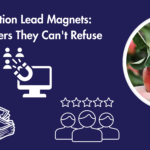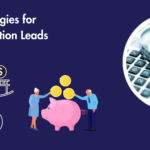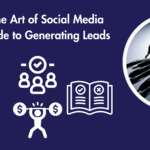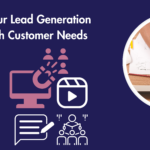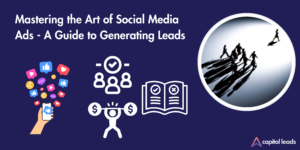The lending industry is highly competitive, and the key to success lies in generating leads – the process of attracting people who are potentially interested in taking out a loan.
Effective lead generation is crucial because it helps lenders find new customers and keeps their business growing.
Lead generation is essential in the lending sector because it’s the first step in building a relationship with customers. It’s not just about getting a long list of potential clients; it’s about finding the right ones who are most likely to take out a loan and stick with it.
Today, people’s habits have changed a lot, especially with how they use digital technology, and lenders need to keep up. Lenders must reach potential clients effectively, communicating with them clearly and at the right time.
By focusing on the most likely customers, lenders can use their marketing budget more efficiently.
Also, the rules around lending are always changing, and customers now expect more personal service. Lenders who are good at generating leads will be better at understanding and meeting these needs. This helps them stay in line with regulations and keep their customers happy.
In this guide, we’ll explore the different ways lenders can generate leads, from online marketing to building local community connections, and how to do this within the rules. There are practical steps that can help lenders not just attract people who might want a loan but turn them into loyal clients.
Understanding Your Target Audience
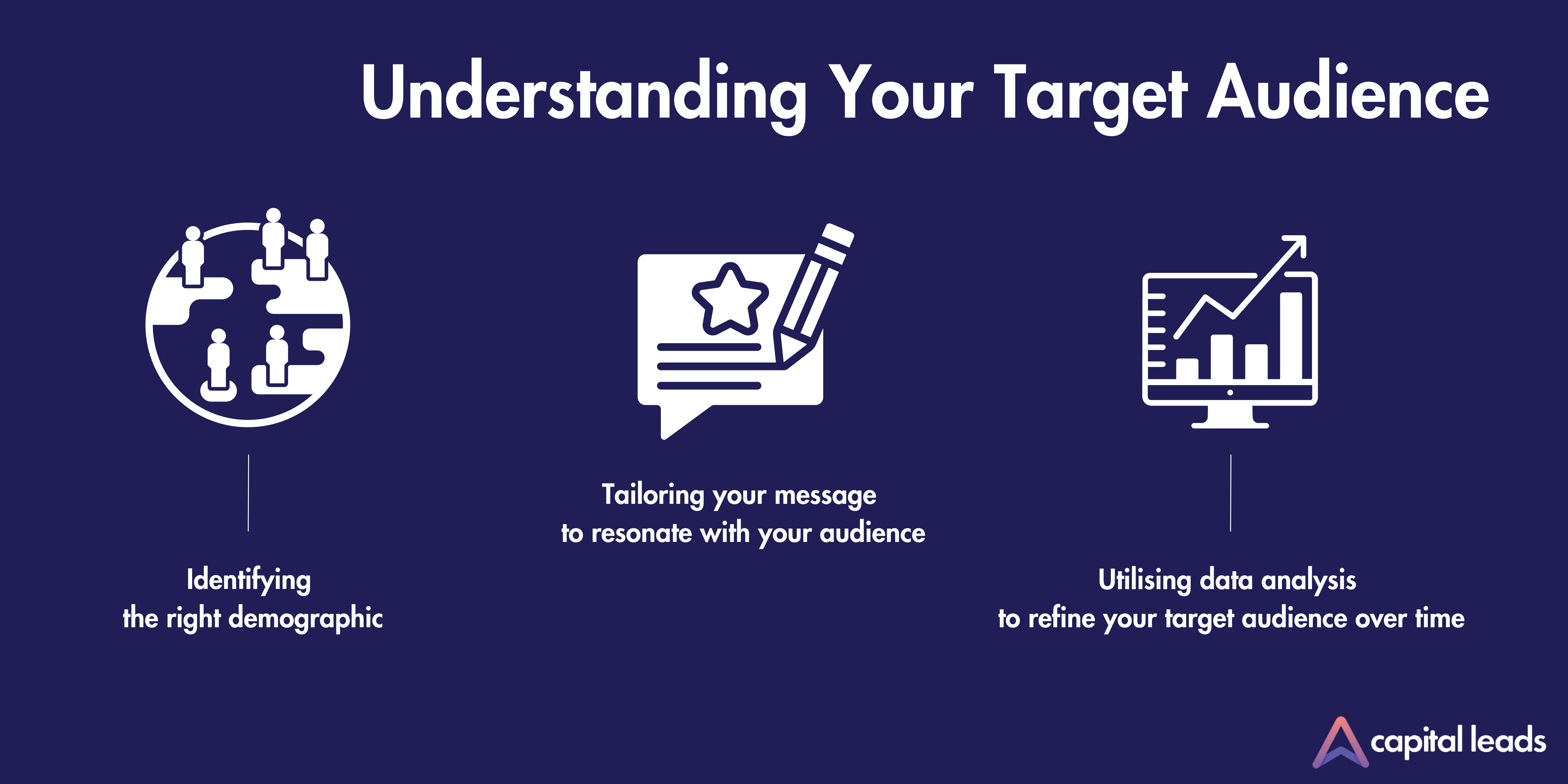
For lenders, knowing who to target is as important as the product offered. A well-defined audience is the foundation of effective lead generation. This section details the process of identifying and understanding the ideal customer profile.
Identifying the right demographic
Every lending product has an ideal borrower. Identifying the right demographic involves understanding various attributes of potential customers such as their age, financial health, and personal interests.
For instance, a mortgage lender might focus on young families looking to buy their first home, while a personal loan provider might target individuals with a stable income who need extra funds for a personal project.
By pinpointing these characteristics, lenders can direct their marketing efforts more effectively.
Tailoring your message to resonate with your audience
Once the target demographic is identified, the next step is to craft messages that speak directly to them. This isn’t just about what is said, but how it is said.
The tone, language, and even the medium of communication should align with the preferences of the potential borrower.
For example, professional language and detailed information might appeal to a financially savvy borrower, while a more straightforward and reassuring tone might be better suited for first-time loan seekers.
Utilising data analysis to refine your target audience over time
The lending market and consumer behaviours are always evolving. Lenders should use data analysis to keep up with these changes. By examining data from past campaigns, customer interactions, and market research, lenders can gain insights into which strategies are working and which are not.
This continuous process of analysis allows lenders to refine their understanding of their target audience, leading to more personalised and effective lead generation over time.
Digital Marketing Strategies

In the digital era, lenders must have a robust online presence to connect with potential clients. This section unpacks several digital marketing strategies that can boost online visibility and attract quality leads.
Search Engine Optimisation (SEO): Best Practices for Lenders.
SEO is about making your website more visible on search engines like Google. For lenders, this means using the right keywords that potential borrowers are searching for, creating informative content, and ensuring the website is easy to navigate.
Lenders should also make sure their site is mobile-friendly, as a significant portion of users now access the internet via smartphones. Regularly updated content, such as blog posts on financial tips, can also help lenders rank higher in search results.
Pay-Per-Click (PPC) Advertising: Crafting Effective Campaigns
PPC ads are a way to jump to the top of search engine results by paying for clicks. Lenders can use PPC to target specific keywords related to their products.
It’s important to write clear and compelling ad copy, choose the right keywords, and set an appropriate budget. Tracking the performance and tweaking the ads can help optimise spend and improve lead quality.
Content Marketing: Blogs, eBooks, and Whitepapers as Lead Magnets
Content marketing involves creating valuable content to attract and engage a target audience.
For lenders, this could be blog posts explaining different loan products, eBooks on financial health, or whitepapers on market trends.
These resources can establish a lender’s authority in the financial field and serve as lead magnets by requiring readers to submit their contact information to access more detailed content.
Social Media Marketing: Engaging Potential Leads on Various Platforms
Social media platforms are where many potential borrowers spend a considerable amount of time. Lenders can use these platforms to share content, answer questions, and even run targeted ads.
The key is to choose the right platforms where their target audience is most active, be it LinkedIn for professionals, Instagram for a younger audience, or Facebook for a broad demographic.
By implementing these digital marketing strategies, you can improve your online visibility, target their audience more effectively, and generate quality leads that have a higher chance of conversion.
Leveraging Technology for Lead Generation
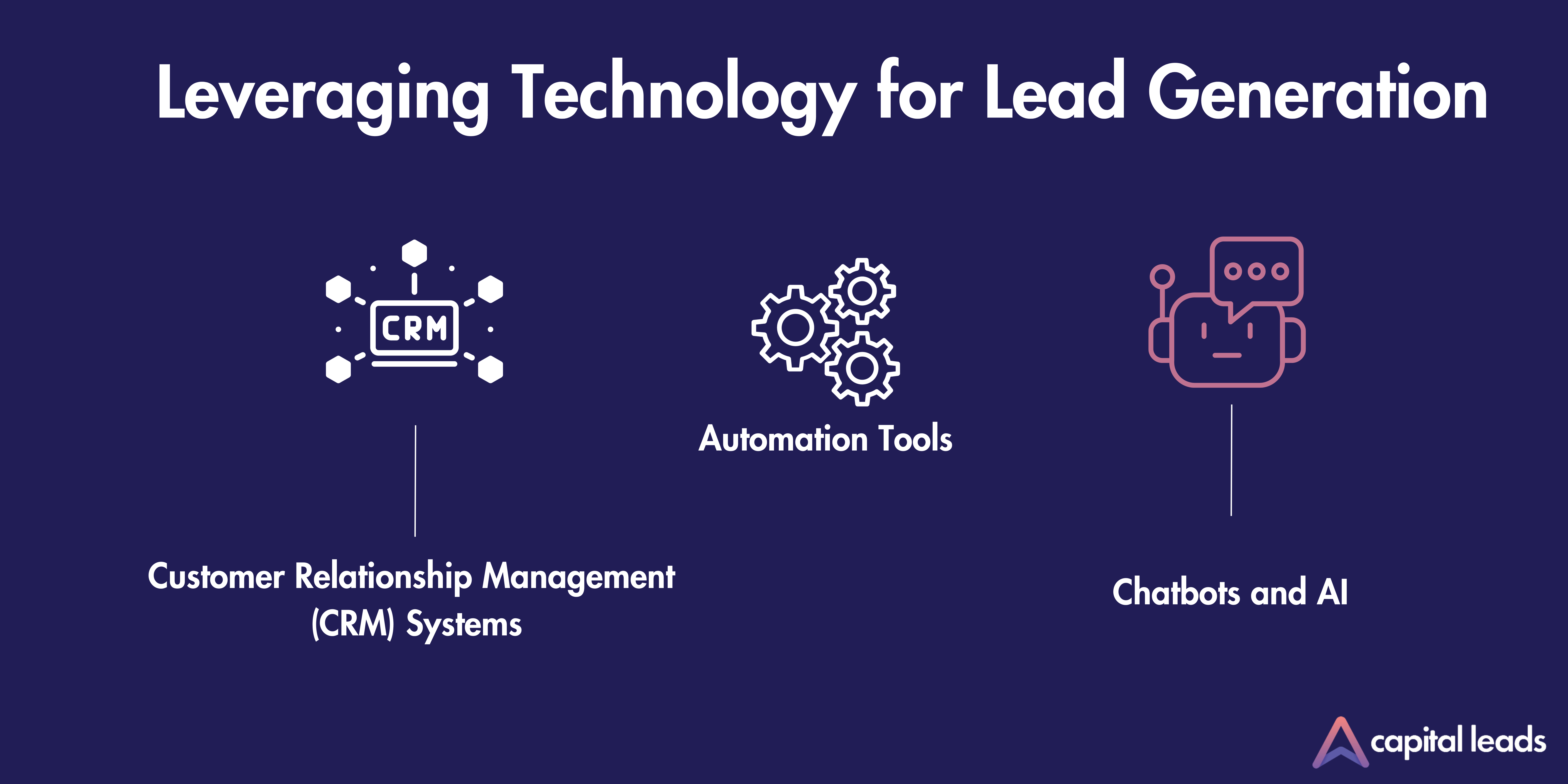
Modern technology offers lenders innovative tools to enhance their lead generation efforts. This section explores how technology can be leveraged to not only attract leads but also to nurture and convert them efficiently.
Customer Relationship Management (CRM) Systems
CRM systems are invaluable for managing interactions with current and potential customers. They help lenders keep track of customer information, communications, and preferences, which can be used to tailor future interactions and offers.
A good CRM system can segment customers based on their behaviour and demographics, enabling personalised marketing campaigns that are more likely to convert leads into clients.
Automation Tools for Streamlining the Lead Generation Process
Automation tools can take over repetitive tasks such as sending out emails, scheduling appointments, or updating lead status. This frees up time for loan officers to focus on more complex tasks, like closing deals.
Automated workflows can ensure that leads are nurtured at each stage of the conversion process, from initial contact to loan application, without any potential customer slipping through the cracks.
Chatbots and AI: Enhancing customer interaction and qualification
Chatbots and AI can provide immediate responses to potential clients visiting a lender’s website or social media page.
These tools can answer common queries, provide information on loan products, and even guide visitors through the initial stages of the loan application process.
AI can further qualify leads by analysing customer data and behaviour, predicting which leads are more likely to convert.
Networking and Partnerships
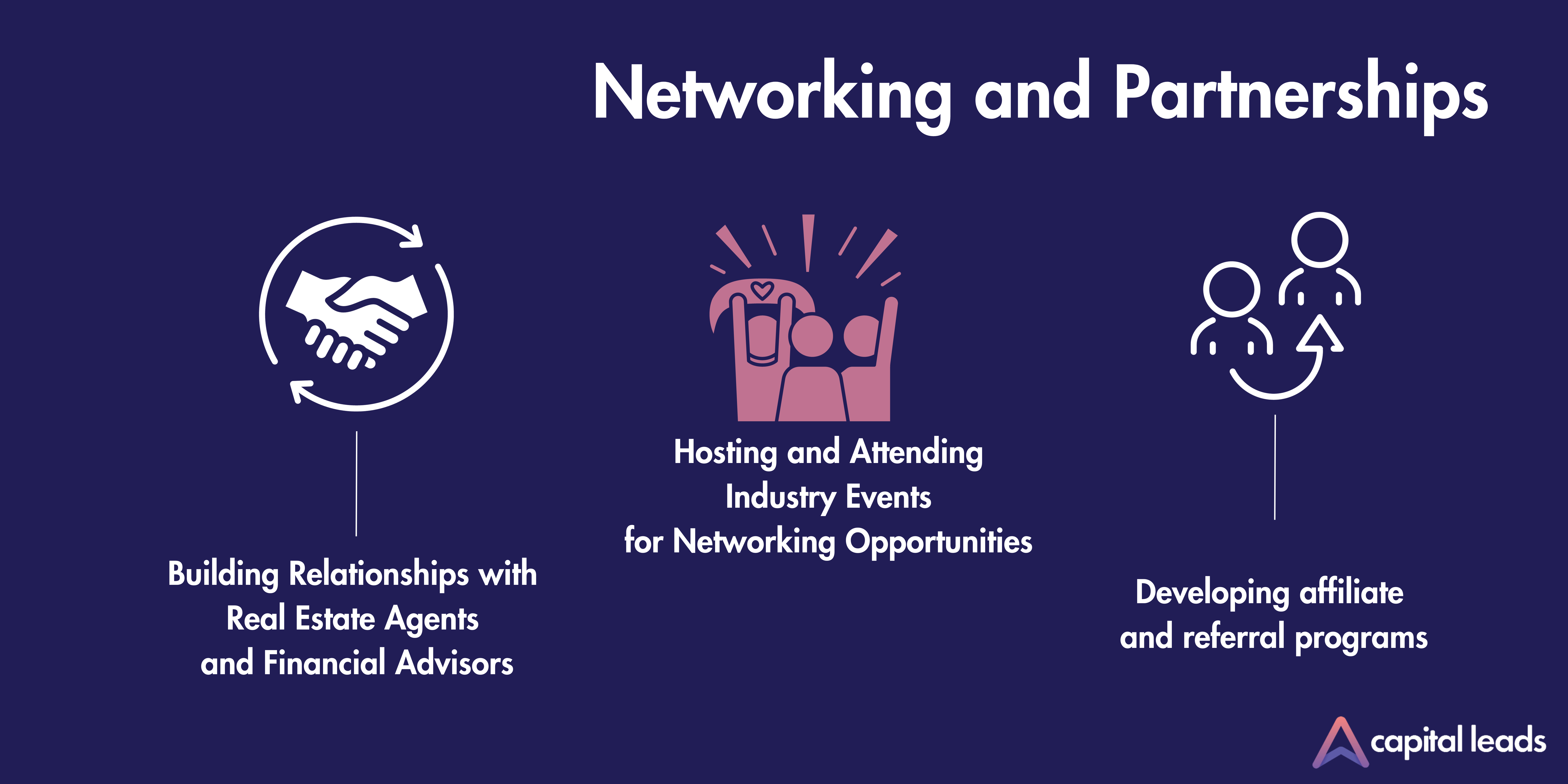
For lenders, forging strong connections within the industry can open up a wealth of opportunities for lead generation. This section discusses the importance of networking and forming strategic partnerships.
Building Relationships with Real Estate Agents and Financial Advisors
Real estate agents and financial advisors are often the first points of contact for individuals considering property purchases or seeking financial guidance.
By establishing strong relationships with these professionals, lenders can position themselves as the go-to choice for financing solutions.
This can be achieved through regular communication, joint marketing efforts, and by providing them with value-added information that they can pass on to their clients.
Hosting and Attending Industry Events for Networking Opportunities
Industry events, such as conferences, seminars, and workshops, are prime venues for lenders to meet new contacts and nurture existing relationships.
Hosting an event can establish a lender’s reputation as an industry leader, while attending events allows them to stay abreast of industry trends, meet potential clients, and engage with other professionals who can refer leads.
Developing affiliate and referral programs
Affiliate and referral programs incentive partners to refer potential leads to lenders. By offering commissions or other benefits to partners for each lead that converts into a client, lenders can harness the networks of various businesses and individuals to reach a wider audience.
Such programs should be designed to be mutually beneficial, ensuring that both the lender and the affiliate see the value in the partnership.
Effective networking and partnership strategies can significantly extend a lender’s reach and can often result in a more consistent and high-quality stream of leads.
Direct Outreach Methods
Direct outreach remains a staple in the lead generation toolkit, allowing lenders to actively engage with potential customers. This section covers best practices for direct outreach methods that can capture the attention of prospects without being overbearing.
Email Marketing Campaigns: Best Practices and Regulations
Email marketing is a powerful tool for reaching out to potential leads directly. For lenders, it’s crucial to craft emails that are informative, engaging, and compliant with regulations such as the GDPR.
Emails should offer real value, like financial tips or insights into loan products, and should include clear calls to action. It’s also important to maintain a clean mailing list and to get recipients’ consent before sending marketing materials to respect their privacy and abide by anti-spam laws.
Cold Calling Techniques
Cold calling can be effective if done respectfully and strategically. Lenders should ensure their calling lists are up to date and that the individuals contacted have not registered with do-not-call lists.
The initial conversation should be brief, focusing on understanding the recipient’s needs and whether they might be interested in the lender’s services.
It’s also beneficial to call at appropriate times and to quickly respect a potential customer’s wishes if they’re not interested.
Direct Mail: A Traditional Approach in the Digital Age
While digital methods are prevalent, direct mail still has its place, especially when targeting demographics less active online.
Lenders can send postcards, brochures, or personalised letters to introduce their services. The key is to make the mail visually appealing and the message clear and concise.
Tracking response rates to direct mail can help lenders refine their mailing lists and offers.
Each of these direct outreach methods requires a balance between assertiveness and respect for potential customers’ time and preferences. When done right, they can be a personal and effective way to generate leads.
Measuring and Analysing Results
The final piece of any lead generation strategy is to measure its effectiveness and make data-driven decisions for improvement. This section delves into the methods for assessing the performance of lead generation activities.
Setting up Key Performance Indicators (KPIs) for Lead Generation
KPIs are metrics that lenders can use to evaluate the success of their lead generation strategies. These should be specific, measurable, achievable, relevant, and time-bound (SMART).
Common KPIs include the number of new leads generated, the conversion rate of leads to loan applications, and the cost per lead.
By setting clear KPIs, lenders can objectively assess which strategies are working and where resources should be allocated.
Using Analytics to Track Performance and ROI
Analytics tools can track the journey of a prospect from the first point of contact through to loan closure. Lenders can use this data to understand which channels are most effective at acquiring leads and which are best for conversion.
Tracking the return on investment (ROI) for each channel is also essential. This helps lenders know where each marketing pound is going and what it’s returning in terms of new business.
A/B testing: Fine-tuning Strategies for Better Outcomes
Also known as split testing, A/B testing involves comparing two versions of a webpage, email, or other marketing material to see which performs better.
By changing one element at a time, lenders can gather evidence about the impact of that change. This could be as simple as testing different call-to-action phrases or as complex as trying out different landing page designs. A/B testing is a powerful method for incrementally improving lead generation efforts over time.
A Checklist for Lenders to Assess Lead Generation Efforts

A comprehensive checklist is crucial for lenders to systematically evaluate and refine their lead generation strategies. Below is a checklist that lenders can use as a part of their regular review process:
Target Audience Clarity:
- Have you clearly defined your target audience demographics, including age, income, and interests?
- Is your messaging tailored to the specific needs and preferences of your audience segments?
Digital Marketing Implementation
- Is your website optimised for search engines with relevant keywords and content?
- Are your PPC campaigns targeted, with clear copy and a strong call to action?
- Do you have a content marketing strategy in place, offering valuable resources like blogs, eBooks, or whitepapers?
- Are you actively engaging with your audience on the right social media platforms?
Technology Utilisation
- Are you effectively using a CRM system to manage leads and customer interactions?
- Have you implemented automation tools to streamline the lead nurturing process?
- Are chatbots or AI being used to enhance initial customer interactions and lead qualification?
Networking and Partnerships
- Do you have established relationships with real estate agents, financial advisors, or other relevant professionals?
- Are you regularly attending or hosting industry events for networking purposes?
- Have you set up affiliate or referral programs to generate leads through partnerships?
Direct Outreach Assessment
- Are your email marketing campaigns compliant with data protection regulations and delivering value to the recipients?
- Is your cold calling approach respectful and non-intrusive, yet effective?
- Are you tracking the response rates and ROI of your direct mail campaigns?
Compliance and Ethics Review
- Are you fully compliant with GDPR and other relevant data protection regulations?
- Is your marketing material honest, clear, and not misleading in any way?
Performance Measurement
- Have you established clear KPIs for your lead generation efforts?
- Are you using analytics tools to track performance and ROI effectively?
- Are you conducting A/B testing to improve conversion rates and other critical metrics?
Overall Strategy Evaluation
- Do you review your lead generation strategy regularly to identify areas for improvement?
- Are you keeping abreast of industry trends and adjusting your strategies accordingly?
- Is there a feedback loop in place for learning from both successful and unsuccessful lead generation tactics?
By routinely going through this checklist, lenders can ensure that their lead generation strategies are not only current and effective but also set up for long-term success and adaptability.
Conclusion
technology, and strong partnerships. It’s also about ensuring you’re playing by the rules and consistently reviewing the impact of your strategies.
In the dynamic world of lending, your willingness to adapt and personalise your lead generation process is what will truly distinguish you from the rest.
It’s not only about keeping up with best practices but also about bringing your unique flair to the table.
At Capital Leads, we specialise in generating high-quality, data-verified leads across a variety of sectors, including solar, home improvements, and financial services.
We’re passionate about lead generation and dedicated to powering the expansion of ambitious companies.
We invite you to harness the insights from this guide to enhance your lead generation strategy. And if you’re seeking a partner to help steer through the lead generation maze, Capital Leads is ready to assist.
Embark on your journey to business growth by visiting us at Capital Leads or make your move by getting started with us at Capital Leads today.
Let’s work together to forge a path of growth, creativity, and triumph in the lending sector.



